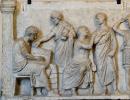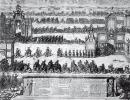“Cheryomukha”, analysis of the poem by Sergei Yesenin. Yesenin bird cherry analysis Fragrant bird cherry with spring author
Bird cherry fragrant
Bloomed with spring
And golden branches,
What curls, curled.
Honey dew all around
Slides along the bark
Spicy greens underneath
Shines in silver.
And nearby, by the thawed patch,
In the grass, between the roots,
The little one runs and flows
Silver stream.
Bird cherry fragrant
Having hung himself, he stands,
And the greenery is golden
It's burning in the sun.
The stream is like a thunderous wave
All branches are doused
And insinuatingly under the steep
Sings her songs.
Analysis of the poem “Bird cherry” by Yesenin
Most of S. Yesenin's early work is devoted to landscape poetry. The young peasant poet sought to reveal to his readers the wonderful world of Russian nature. Memories of his native village allowed Yesenin to create very pure, heartfelt works that accurately conveyed his feelings. One of them is the poem “Bird cherry” (1915).
The focus of the enthusiastic observer is the “fragrant bird cherry”. An ordinary tree is completely transformed with the onset of spring. Bird cherry appears in the guise of a young beautiful girl who has curled her curls. She is aware of her dazzling beauty, which makes her even more charming.
Bird cherry blossoms along with all the surrounding nature. Yesenin uses a rich color palette in depicting the landscape: “golden branches”, “greenery”, “in silver”. The dynamism of the overall picture is given by the flowing “silver stream”, which sings “songs” to the bird cherry tree. Thus, the image seems to come to life, filled with various sounds.
The bird cherry and the stream can symbolize two lovers, whose feelings awakened for the first time under the influence of spring. The “ingratiating” singing of a brook resembles a young man’s passionate declaration of love. Endowing plants and animals with human traits was generally a favorite technique of Yesenin, who did not separate man from nature.
A characteristic feature of Yesenin’s landscape lyrics is the absence of a lyrical hero. The figure of the observer is only assumed. The poet allows readers to look at the magical picture with their own eyes.
The work is written in a very simple and understandable language. Various epithets give it special beauty and lyricism: “fragrant”, “honey”, “explosive”. A common technique for Yesenin’s early lyrics is the use of personification: “the dew... slides,” “the stream... sings.” The poet also uses original metaphors: “the greenery... burns in the sun”, “it showers all the branches with a rattling wave.” The only comparison (“like curls”) will become traditional for Yesenin and will subsequently be used by him very often.
The spring transformation of nature was not chosen by Yesenin by chance. It was very close to his own condition during this period. The young poet recently moved to Moscow. He is full of hope and confident in his own abilities. Yesenin associated his entry into the poetic world with the beginning of a new life. He was in a state of powerful spiritual uplift. This feeling became the “calling card” of the new Russian poet, with the help of which he managed to conquer the discerning Moscow public.
“Bird cherry” Sergei Yesenin
Bird cherry fragrant
Bloomed with spring
And golden branches,
What curls, curled.
Honey dew all around
Slides along the bark
Spicy greens underneath
Shines in silver.
And nearby, by the thawed patch,
In the grass, between the roots,
The little one runs and flows
Silver stream.
Bird cherry fragrant
Having hung himself, he stands,
And the greenery is golden
It's burning in the sun.
The stream is like a thunderous wave
All branches are doused
And insinuatingly under the steep
Sings her songs.
Analysis of Yesenin’s poem “Bird cherry”
In the early works of Sergei Yesenin there are a lot of works that are dedicated to the beauty of his native nature. This is not surprising, since the poet’s childhood and youth were spent in the picturesque village of Konstantinovo, where the author learned not only to understand and appreciate the world around him, but also to notice any little things that characterize its transformation.
Yesenin often said that spring is his favorite time of year, as he can watch how nature awakens after hibernation. In the poet’s work, this period symbolizes new hopes and dreams, and also often reflects the elation that the author experiences. This is precisely the emotional tone of the poem “Bird Cherry,” created by the poet in 1915.
Using the imagery and flexibility of the Russian language, Yesenin endows an ordinary tree with human qualities, presenting the bird cherry in the image of a young girl who “curled golden branches like curls.” The amazing harmony of the surrounding world cannot leave the poet indifferent, and he notes how “honey dew” slides down the trunk of the bird cherry tree, and a “small silver stream” flows near its roots.
The spring awakening of nature evokes romantic thoughts in the poet, so the image of a stream in the poem symbolizes a young man in love who is just beginning to discover this tender and exciting feeling. Therefore, Yesenin draws a parallel between the human world and nature, focusing on the fact that the bird cherry tree and the stream remind him of young lovers who do not dare admit their feelings to each other. The tremulous bird cherry is beautiful in its timid beauty, and its “golden greenery burns in the sun.” As for the stream, it gently irrigates its branches with melt water and “ingratiatingly sings a song to it under the steep slope.”
An imaginative perception of the world is characteristic of all works of Yesenin’s landscape lyrics without exception. He knew how to see what others did not notice in the everyday bustle, and found such precise and delightful words to convey the beauty of ordinary natural phenomena that few could remain indifferent to his poems. In later lyrical works, the author more and more often depicted snow blizzards and cold autumn rain, which in their essence were in tune with the poet’s mood. However, the landscape lyrics of the initial stage of Yesenin’s work are painted in gentle and rich tones, filled with purity, joy and peace.
Bird cherry fragrant
Bloomed with spring
And golden branches,
What curls, curled.
Honey dew all around
Slides along the bark
Spicy greens underneath
Shines in silver.
And nearby, by the thawed patch,
In the grass, between the roots,
The little one runs and flows
Silver stream.
Bird cherry fragrant
Having hung himself, he stands,
And the greenery is golden
It's burning in the sun.
The stream is like a thunderous wave
All branches are doused
And insinuatingly under the steep
Sings her songs.
(1
votes, average: 5,00
out of 5)
More poems:
- A pear and a bird cherry are aimed at me - With their crumbly force they hit me without missing a beat. Brushes together with stars, stars together with brushes - What kind of dual power is there? In whose inflorescences is the truth? WITH...
- The boy sat by the stream, The boy looked at the stream; Fresh, red-cheeked, With a yearning soul He rushed to a distant land behind the running wave. “How cramped it has become for me here! Here in the dull silence A little...
- March transparent saxaul flows iridescently along the road. Who was it that flew up from the wire? Rejoice that you can still easily distinguish a jay from a magpie; And the highway flows along the dune, And remains somewhere...
- Look: by the pond, where the heat flows into the cool shade through the trembling willow branches, midges fly; the sparkling day gave birth to them, And they will die by night, having lived a moment. And others will be born in...
- He stands silently before the governor; He lowered his head and looked gloomy. The velvet caftan was removed from the shoulders of the mighty; Blood flows quietly from wide wounds. He is shackled at the feet, shackled at the hands: You know...
- In the Carian grove, dear to the hunters, there lurks a cave, Slender pines bend their branches all around, and its entrance is obscured by the shadow of Ivy, wandering freely in the windings, lover of rocks and crevices. From stone to...
- When the dawn, shining through the pine forest, Burns and burns, and the forest no longer sleeps, And the shadows of the pines fall into the river, And the light runs onto the streets of the village, When, laughing, in a deaf courtyard They greet...
- 1 Everything - mountains, islands - all of the morning steam Covered with haze... Like a sweet dream, As if a light, silver spell had been cast on the world - and it dreams of happiness... And, with...
- There was everything - the tyrant king, and the plague among the burning streets... The silver cord did not break, the links of time did not unbend. The wars lasted for a thousand years... they took away the rust on their faces... And there was no water...
- The white birch tree under my window is covered with snow, like silver. On the fluffy branches, like a snowy border, brushes blossomed like a white fringe. And the birch tree stands in sleepy silence, And snowflakes burn in golden fire....
- The Terek rushes between the mountain walls, sweeps the wild shore in waves, bubbles around huge rocks, digs a road here and there, like a living beast, roars and howls - And suddenly it calms down and...
- There the wall came almost to the wall, And they had neither a door nor a window. And between them, so that the bottom is visible, a stream runs - the name is the same. It was once full...
“Bird cherry” by Yesenin S.A.
Sergei Yesenin became famous thanks to his amazing ability to create a unique world of feelings, experiences, the beauty of nature and animals. The author paints vivid pictures for readers, writes easily and clearly. And before my readers’ eyes, living images of plants, nature, and animals appear.
In the poem "" the poet manages to not only depict a plant surrounding nature, as an artist could do. Sergei Yesenin uses all the rich means of language. The poet understands perfectly well that only a word can tell about everything: make readers see the bird cherry, hear the sound of flowing water, feel a subtle aroma, feel the touch of hot greenery and the running wave of a stream.
The poem was written by Sergei Yesenin in 1915; in the same year the work was published in the Mirok magazine. The March issue introduced readers and fans of the poet’s work to his new poem about nature.
The surrounding world is conveyed here in all shades, in colors and sounds, smells, in movement. The work belongs to the “village” direction. Sergei Yesenin has quite a lot of poems that tell readers specifically about nature, animals, the elusive life of the wonderful multifaceted world around us, which most often we simply do not notice.
Plot, composition, rhyme
In the poem “Cheryomukha” the poet shares his own impressions of nature. However, the image of the lyrical hero is not written out here. It is worth noting that in such poems, which are more likely Yesenin’s lyrical monologues about nature, animals, and the surrounding world, most often there is no lyrical hero. The author does not focus on it, since when we read such works, we ourselves should feel like a part of the world around us. The reader is transported to a specific space: a stream runs here, bird cherry smells, greenery heats up in the sun, dew rolls down the bark. Sergei Yesenin creates such a bright, multifaceted picture that he achieves a real effect of presence.
Plot there is no such thing in the work, however, the poet talks about nature with logical consistency, uses refrains. A very original solution, characteristic of the poet’s work, - personification plants, natural objects. If you read the poem carefully, you can safely say that here Yesenin revealed to us the secret of the emerging love of a beautiful blooming bird cherry and an energetic stream, which insinuatingly sings songs to her, like serenades.
Composition The work is linear, there is also an element of circular construction, the refrain of the first line. Work written iambic bimeter. Cross rhyme: the second and fourth lines, the first and third rhyme. The poem is not divided into stanzas, although it can be conditionally divided into five stanzas of four lines each. There are twenty lines of medium length in the work.
Artistic means in the poem “Bird cherry”
The short poem contains a rich kaleidoscope of artistic means that Sergei Yesenin masterfully uses. The first four lines use colorful epithets (fragrant, golden), comparison (branches, curls), personification (bird cherry curled). The tree appears as a young girl with golden fragrant branches, which she curls herself. This is bird cherry in its heyday, when the long-awaited spring comes.
In the next four lines, Yesenin paints a picture of the world around him. In it, as if in a beautiful frame, the bird cherry tree shines. Colorful colors are used here epithets (honey, spicy, shines in silver), comparison (in silver - in dew), personification (slips, as if the dew is deliberately slowly sliding down the bark, rather than just flowing down it). You can feel nature, the spicy smell of greenery.
Next, the poet talks about the stream - the bird cherry’s wonderful neighbor. Everything happens near the tree; the bird cherry remains the main character, although it is not directly mentioned. There was greenery under the bird cherry tree, a stream ran next to it. In these lines you can see a thawed patch, grass and tree roots, between which a stream flows. It's small and silver. Used again here epithet, colorful adjective.
In the following lines, the author returns to the main character of the poem and repeats the first line again. The bird cherry is standing "hung", golden greenery burns, warms up in the sun. The poem ends with a description of the stream, which washes over the bird cherry branches with waves and sings songs to it. Here we see expressive definitions ( like a thunderous wave, insinuatingly), personification (the stream sings songs).
So Sergei Yesenin told readers about the beauty of the stream, spring greenery, and beautiful bird cherry. In the poem, the sound of running water is heard, the aroma of greenery and bird cherry branches is felt, and the burning of grass heated by the sun is felt. The richness of Yesenin’s language, his ability to skillfully use artistic means and create memorable images were fully demonstrated here.
Analysis of the poem Cheremukha Yesenin for grades 3, 5, 6
Plan
3.Tropes and images
4.Size and rhyme
Sergei Yesenin (1895 - 1925) is a great Russian poet who comes from a peasant family. Yesenin loved Russia and wrote about the splendor of its landscapes, describing his native places. In his poems, he endowed inanimate objects with human qualities. He conveyed pictures of nature with incredible ease and expressiveness, masterfully using the flexibility of the Russian language.
History of creation
Since Yesenin grew up in a rural area, his work contains many poems about the amazing, living, enchanting world around us, the beauty of which we often do not notice. The poet's favorite time of year was spring - the period of awakening and flowering of life. This is what the poem “Bird Cherry” is dedicated to. The author wrote it at the age of 20, in 1915. Then in March the work was published in the magazine “Mirok”. The poet's lyrics contain a large number of poems about the delightful world around us, the charm of which we often lose sight of.
Genre
Poetry in literature refers to lyric poetry. Lyrics are a type of literature based on the emotional experience of the poet’s feelings and emotions. There are a variety of genres in lyrics, each of which has its own characteristics. The description of the nature around refers to landscape poetry. This is verbal art, Yesenin depicts the world around him, making it the main theme of his poems.
Paths and images
Yesenin professionally uses a variety of artistic means in his works. For example, in this poem there are such literary expressions as: Epithets, comparisons, personification. The lines of the poem “Bird cherry” describe spring, represented by a description of several specific elements of bird cherry, dew, grass, and stream. Yesenin had an amazing ability to share his mood, his impression, so that the reader could feel himself among the picture described.
Meter and rhyme
The size of the verse (the number of lines in one line; a line is a combination of one stressed syllable with one or more unstressed ones). The poem “Bird cherry” uses iambic bimeter. Cross rhyme: the second and fourth lines, the first and third rhyme. A linear composition has been produced.
Plot
The plot itself is missing. The author describes his personal vision of the world around him. The lyrical hero is also not defined; the verse is dedicated to the landscape as a whole. Yesenin focuses on one specific object, but allows the reader to imagine what is happening as a whole.
Main thought
In the poem “Bird Cherry” there is an amazing revival of nature. The reader is conveyed the mood of spring, a feeling of lightness and inspiration. This cheerful picture seems to appear around you and play with all the colors of spring; in fact, you begin to feel the aroma of blooming bird cherry and young grass, hear the ringing of the stream, feel the warmth of the sun's rays. Yesenin fully revealed here all the amazing beauty of nature, the fullness of its life.
The poem “Bird Cherry” is filled with that special light that only Yesenin could create. He skillfully immersed the reader in the natural world and showed him the beauty of this world. A brief analysis of “Bird Cherry” according to plan will help 3rd grade students appreciate the beauty of Yesenin’s poetry. Using it in a literature lesson, you can easily explain the material of the program.

History of creation– Yesenin wrote “Cheremyukha” in 1915, and the reader was able to get acquainted with him already in the March issue of the magazine “Mirok”.
Theme of the poem- a story about bird cherry.
Composition– one-part linear.
Genre- landscape lyrics.
Poetic size- iambic bimeter with cross rhyme.
Epithets – “fragrant bird cherry”, “golden branches”, “honey dew”, “silver stream”, “golden greenery”.
Metaphors – “green shines in silver”, “green burns in the sun”.
Comparison – “what curls”.
Personification – “The bird cherry has curled its branches,” “the stream is running,” “the stream is singing songs.”
- History of creation
- Composition
- Means of expression
Sergei Yesenin wrote “Cheremukha” in the early period of his work - in 1915, and you can even roughly determine the months - this is January-February. The fact is that this poem was already published in the March issue of the Mirok magazine, which means it was written before that.
The work describes bird cherry, which is its main theme. The author creates a surprisingly lively image, including in the picture not only the tree, but also the nature surrounding it. He shows the world in both colors and sounds, using a rich literary arsenal to make his description unique.
There is a second layer of the work: Yesenin seems to be telling a love story that is just emerging between a young girl (bird cherry) and a young guy (creek).
There is no lyrical hero in this verse - the poet simply shares his impressions of the world, shows how beautiful it is. A simple linear composition with a small ring element is great for this: it’s worth paying attention to the refrain of the first line.
Reading this poem helps the reader feel part of the world around him. Yesenin first shows the reader a bird cherry tree, which blooms thanks to the spring warmth, then turns his attention to a bushy tree running between its roots, and then returns to the bird cherry tree again. As a skilled artist, he shows both the overall picture and the details that form it.
This is a classic of landscape poetry, one of the poet’s most famous works. It is very characteristic of his early work, where he poeticized his native nature and showed its most beautiful sides.
As in other works related to early lyric poetry, “Cheryemukha” uses a wide variety of artistic means, such as:
- Epithets- “fragrant bird cherry”, “golden branches”, “honey dew”, “silver stream”, “golden greenery”.
- Metaphors- “green shines in silver”, “green burns in the sun”.
- Comparison- “what curls.”
- Personification- “the bird cherry has curled its branches,” “the stream is running,” “the stream is singing songs.”
With their help, Yesenin immerses the reader in the world of sounds, aromas and colors, which creates a wonderful poetic canvas. Rich language and skillful use of paths allowed the poet to write truly beautiful landscape poems that do not lose their charm and charm even after more than a hundred years.
One fine morning on my father’s desk I noticed a collection of poems by Sergei Alexandrovich Yesenin, and I don’t know what attracted me to this book. I opened it randomly and came across the poem Cheremukha. This poem describes the bird cherry tree, so beautifully and picturesquely that the image of a snow-white flowering tree involuntarily appeared before my eyes. For a moment I even thought I smelled the scent of bird cherry blossoms.
Yesenin very picturesquely describes the bird cherry, close your eyes and say these first lines of the poem, can you imagine? In his poem, Yesenin associates bird cherry with a living person, using comparisons of tree foliage with curls and golden branches. Unwittingly, such a description of bird cherry resembles a female image. Where the white color of flowers is a symbol of youth and not corruption of virgin purity. Poets often applied such epithets to Russian beauties.
Reading this poem, my subconscious involuntarily revealed a spring landscape, when everything wakes up after winter blizzards and colds, as if the beginning of a little life, as the summer period of time in the year is usually called. The lines about dew give the imaginary picture the time when the action takes place, and for some reason I am sure that this time is an early spring morning, when the snow has already passed, small foliage has blossomed, and in the morning dew forms on the leaves, smelling of morning freshness and fog.
Does your teacher check for plagiarism? Order a unique work from us for 250 rubles! More than 400 completed orders!
The epithets used to describe the bird cherry - golden curls, silver dew - certainly speak of the value and beauty of this moment, which cannot be compared with anything. The picture is especially well complemented by a rustling stream; having read up to this point, at the end of the poem a complete natural picture has formed, which you involuntarily want to draw on canvas, picking up a brush and paints. Look how interestingly the bird cherry tree describes the surrounding state, and next to the thawed patch a silvery stream gurgles, and the stream sings songs to it. The stream is beautifully described thanks to the poet, we understand that the stream is like a living one.
In conclusion of my essay, I would like to add that Yesenin is very good at conveying the properties and moods of the human soul through natural phenomena. This property is typically Russian; only Russian people can talk about soulless objects and phenomena as if they were animate. Closing the book, I didn’t even notice how time flew by until lunch.
Post Views: 51






